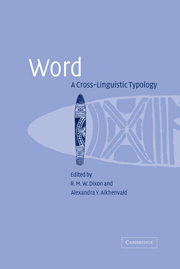Book contents
- Frontmatter
- Contents
- List of contributors
- Preface
- List of abbreviations
- 1 Word: a typological framework
- 2 Typological parameters for the study of clitics, with special reference to Tariana
- 3 The word in Cup'ik
- 4 The word in Eastern/Central Arrernte
- 5 The eclectic morphology of Jarawara, and the status of word
- 6 Towards a notion of ‘word’ in sign languages
- 7 Synchronic and diachronic perspective on ‘word’ in Siouan
- 8 What is a word in Dagbani?
- 9 The word in Georgian
- 10 The word in Modern Greek
- 11 What can we conclude?
- Index of authors
- Index of languages and language families
- Index of subjects
- References
3 - The word in Cup'ik
Published online by Cambridge University Press: 22 September 2009
- Frontmatter
- Contents
- List of contributors
- Preface
- List of abbreviations
- 1 Word: a typological framework
- 2 Typological parameters for the study of clitics, with special reference to Tariana
- 3 The word in Cup'ik
- 4 The word in Eastern/Central Arrernte
- 5 The eclectic morphology of Jarawara, and the status of word
- 6 Towards a notion of ‘word’ in sign languages
- 7 Synchronic and diachronic perspective on ‘word’ in Siouan
- 8 What is a word in Dagbani?
- 9 The word in Georgian
- 10 The word in Modern Greek
- 11 What can we conclude?
- Index of authors
- Index of languages and language families
- Index of subjects
- References
Summary
Introduction
Ideally, the word is a transcendent unit of linguistic organisation serving at once as the maximal domain of lexical phonology, the maximal domain of morphology and the atom of syntax. Our everyday notion of ‘word’, I think it is fair to say, implies just this convergence, as do such scientific theories as the lexicalist hypothesis (of which Lapointe 1980 and DiSciullo and Williams 1987 are among the strongest formulations). This ideal is upheld empirically for a given language when, in the internal organisation of phonology, morphology and syntax, many logically independent processes each refer crucially, in some way, to the same unit or its boundaries, and when that unit is clearly comparable across languages. But to the extent that the ideal may not be upheld in each language, it is important for a general theory to be able to specify the ways in which phonology, morphology, syntax, and perhaps other subsystems may resolve the stream of speech in different, non-convergent ways.
I begin by introducing Cup'ik (§ 2), its typology (§ 3), and the word for ‘word’ in Cup'ik (§ 4). I then turn to the grammatical word (§ 5), the question of clitics and their grammatical status (§ 6), the phonological word (§ 7). I then summarise the mismatching that occurs between the grammatical and the phonological word (§ 8) and end with a brief conclusion (§ 9).
- Type
- Chapter
- Information
- WordA Cross-linguistic Typology, pp. 79 - 99Publisher: Cambridge University PressPrint publication year: 2003
References
- 2
- Cited by

